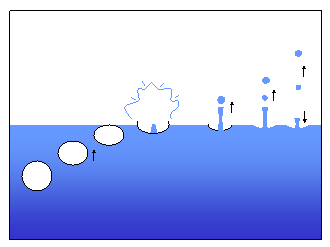|
|
 |
|
|
|
 |
| |
|
|
 |
The Oceans
Read more |
Air-Sea Gas Exchange
Movement of gases occurs both from the atmosphere into the oceans and from the oceans into the atmosphere. The most important factors which influence gas exchange are the difference in the concentration of the gas between the air and the water and the speed of the wind. At the moment, we don't know all the factors which control the movement of gases across the sea surface. Once we know more, we will be better able to determine how important air-sea gas exchange is to our climate and the quality of the air we breathe.
|
|
|
|
|
 |
|
The impact of carbon dioxide (CO2) on our climate depends on how much carbon dioxide there is in the atmosphere. Around a third of the carbon dioxide produced when we burn fossil fuels is transferred acros the sea surface into the oceans. By removing carbon dioxide from the atmosphere, this transfer greatly reduces the potential impact of global warming. Over most of the ocean the movement of man-made carbon dioxide is from the air to the sea. Why is the movement generally in this direction? Both physical and biological processes occur in seawater which allow the oceans to efficiently take up carbon dioxide. Have a look in the Basics Section at the Page on Carbon dioxide in the Unit on Water in the oceans for more details.
Very briefly, once carbon dioxide enters seawater it reacts with the carbonate ions (CO32-) which are present to from hydrogen carbonate (HCO3-). This moves the reaction to the right and allows more carbon dioxide to enter from the atmosphere. |
 |
 |
|
|
|
In addition to this physical removal, carbon dioxide is also taken up biologically through photosynthesis during phytoplankton growth and converted to plant material.
As well as the transfer of gases from the air to the sea, there is also a movement of gases from the oceans to the atmosphere. Climatically important gases such as dimethyl sulphide (DMS) and methyl iodide (CH3I) are produced in the oceans but they only influence climate once they get into the atmosphere. Because their concentrations in air are almost always really low compared to their levels in seawater, they tend to move from the water to the air.
|
 |
 |
|
1. Image of breaking waves from freefoto.com
|
|
 |
We know that gas exchange depends very strongly on the wind speed. Generally the faster the wind, the more gas exchange occurs. One of the reasons why high winds encourage gas exchange is that these high winds produce big waves, make the surface of the sea rough and mix up the waters below.
|
|
As the waves break they introduce billions of bubbles into the surface waters. These bubbles transfer gases from the atmosphere into the water. As well as moving gases from the air to the sea, the bubbles mix up the water. This extra mixing helps gases escape from the water and enter the air.
When the bubbles rise up through the water and reach the surface, they burst and a jet of seawater enters the air. As this jet rises, it breaks up into droplets. The water evaporates and leaves aerosol particles made up of seasalt. Billions of tonnes of salt enter the atmosphere this way. A lot falls straight back into the sea but a significant amount of salt is transported to land. Seasalt aerosol particles are very important in the atmosphere. Not only do they scatter sunlight back into space and so cause a direct cooling of our planet but they also act as very efficient cloud condensation nuclei and start the formation of clouds. In this way they cause indirect cooling of the Earth. This however can be partially counteracted by the greenhouse effect of clouds.
|
 |
 |
|
2. Cartoon of a bubble rising through the sea and bursting, releasing seasalt aerosol into the air. Author: Lucinda Spokes.
|
|
Wind speed isn't the only factor which influences gas exchange. We know that the temperature of the water is important, that rainfall can also increase the emission of gases from the ocean and that the presence of sea ice alters gas exchange rates.
|
 |
 |
|
3. Image from NOAA of work at sea under rough conditions.
|
|
 |
Because gas exchange depends on such a variety of environmental factors, we are still not very good at working out what controls the transfer of gases across the sea surface. One piece of information we really lack is what happens when it's really windy. This is because it's very difficult and not very safe to do field measurements when the ship you are sampling from is rocking and rolling all over the place!
|
About this page:
author: Lucinda Spokes - Environmental Sciences, University of East Anglia, Norwich - U.K.
1. sci reviewer: Prof. Peter Liss - Environmental Sciences, University of East Anglia, Norwich - U.K.
2. sci. reviewer: Dr. Phil Nightingale - Plymouth Marine Laboratory, Plymouth - U.K.
edu. reviewer:
last updated: 2003-10-29
|
|
 |
|









